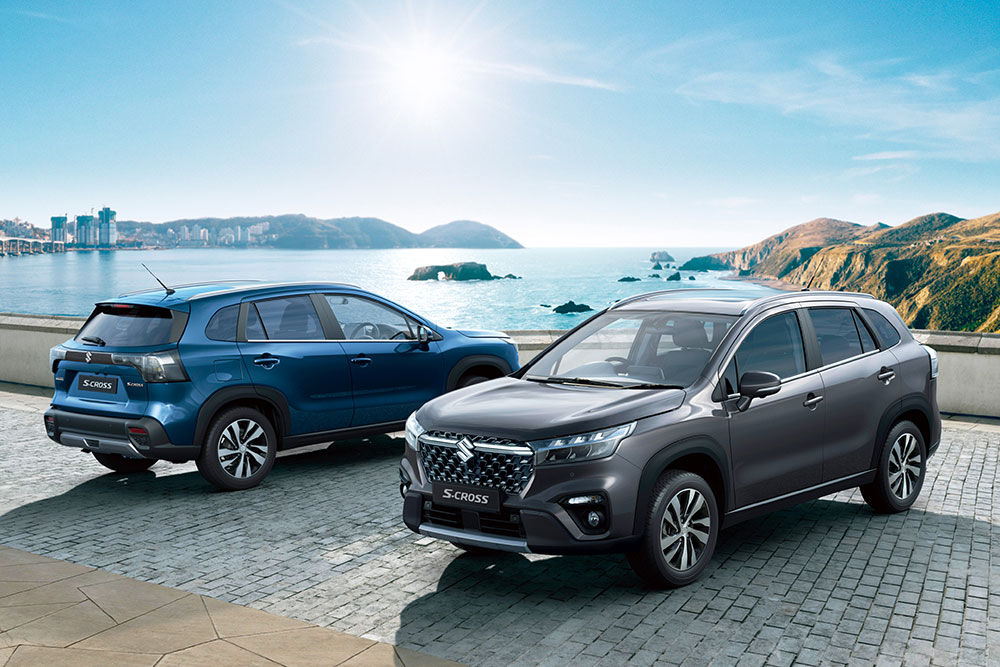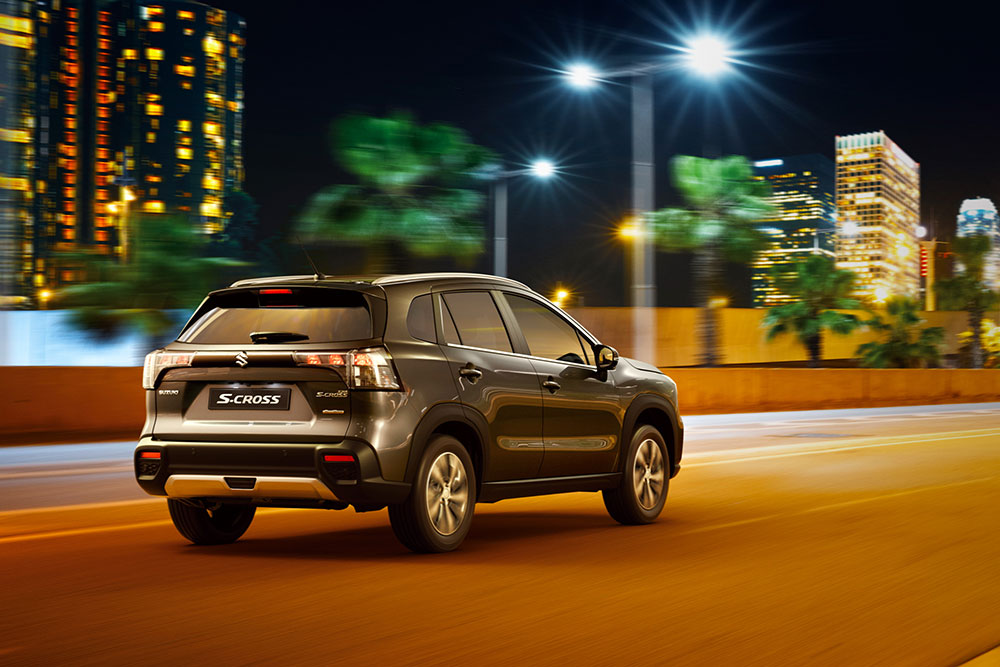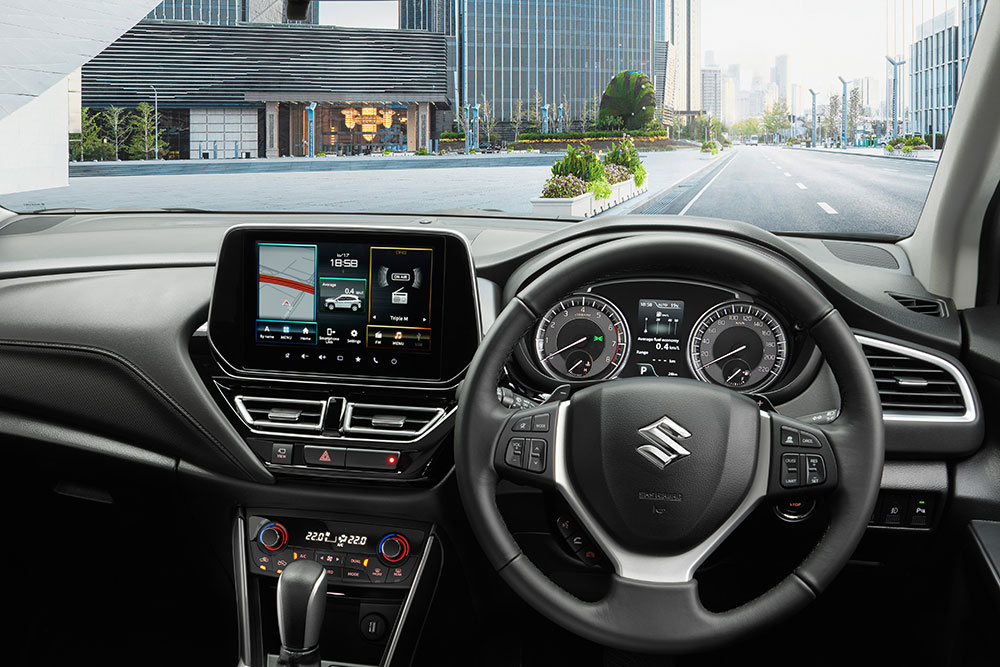Suzuki S-Cross GLX Allgrip MY23 review

Suzuki has built its automotive credentials in this country on a pared-back range of affordable and reliable compact vehicles, but the Japanese car maker is preparing to welcome a wave of new models that will extend its range and appeal.
Already on sale following its late 2022 release is the almost-all-new Suzuki S-Cross, the brand’s flagship model which boasts more angular bodywork than its predecessor, a higher hipline and puts power to all four wheels as designated by the ‘Allgrip’ naming convention.
The company has also announced a longer-wheelbase five-door version of its lightweight, all-terrain-conquering Jimny, plus the new and rather bizarrely named ‘Fronx’, a small SUV that will replace the Baleno hatch.
Previously available only in front-wheel drive guise, the new S-Cross is now exclusively all-wheel drive via a two-variant range comprising the entry-level S-Cross Allgrip priced at $40,990 (MRLP) and the more upmarket Allgrip Prestige costing $44,490 (MRLP).
Queenslanders are given a little more choice and different model grades than the rest of the country, thanks to Suzuki’s legacy split distribution arrangements, which sees the Sunshine State and the NSW northern rivers region handled by one corporate entity, while the rest of the country is handled by Suzuki Australia.
In the Sunshine State, the base model S-Cross Allgrip is known as the GL Plus, while the top of the range is designated as the ‘GLX Plus Sunroof’, with respective pricing identical to the previously referenced national equivalents.
Wedged in between is the $43,490 GLX, which as you might have already guessed is a GLX with the sunroof omitted and the model tested here.
For simplicity, we’ll stick with the two-spec national naming conventions.
The new S-Cross features a bolder and more modern look thanks to its higher bonnet line and distinctive three-LED headlight and taillight design.
The three-LED concept references the triple slot design seen on early Suzuki 4WDs, with nods to this styling motif also found on the current Jimny and Ignis.
The S-Cross interior has also been revamped but retains a familiar-to-the-brand look and feel.
Upgraded model comes at a cost
Suzuki claims it brings an elevated level of comfort and convenience, while maximising interior space within the compact body measurements.
Unfortunately for the stretched hip pockets of Aussie consumers, the new model upgrades also bring hefty price increases over the old S-Cross.
The entry-model S-Cross Allgrip is now $10,000 more expensive than its predecessor, while the Allgrip Prestige asks an extra $12,500.
In a segment that offers plenty of stiff competition including several more budget-friendly models, the steep price hikes detract from Suzuki’s traditional value-for-money offering and may give potential buyers cause to look elsewhere.
Presumably, it’s the inclusion of AWD that’s a large part of the reason for these price hikes, so it’s ironic that the formerly FWD-only range no longer includes a budget-friendly entry-level variant, despite many competitors doing so.
These other brands have long since established that some SUV buyers will happily forego the benefits of AWD for a more affordable price tag, so it’s curious that Suzuki hasn’t followed suit.
Among the small SUV rivals taking the fight to the S-Cross are the recently updated Kia Seltos, with pricing for FWD versions starting at just under $30,000, running up to around $41,500. Seltos AWD models start at just over $39,000 and climb to just under $45,000.
Kia’s Korean cousin Hyundai hops into the ring with its all-new Kona, boasting petrol and petrol-hybrid models as well as FWD and AWD, with prices spanning a range from $32,000 to $46,500.
That’s like the Toyota Corolla Cross which also boasts a mix of powerplants and drivetrains within its eight-model line-up, starting at $33,000 and topping out at $49,000.
Mitsubishi’s Eclipse Cross can be had for an entry price of $31,500, running all the way up to the AWD top-of-the-range variant at $43,000. Mazda’s CX-30 is also right in there on price, starting at around $30,000, or if a Euro is more your thing, the VW T-Roc FWD undercuts the Suzuki, while T-Roc AWD models are priced just $710 higher than the S-Cross Allgrip Prestige.

Not to be outdone, Subaru’s AWD-only Crosstrek is priced between $34,990 and $41,490 depending on variant, while stablemate the Subaru XV is likewise all-paw and priced from $33,190 to $38,490.
If a full electric model appeals, the MG ZS EV range starts at $44,990 drive-away and is made more attractive courtesy of the Queensland Government’s $6,000 zero emissions vehicle rebate (conditions apply).
The point in listing these rivals and their pricing is to underscore that one of Suzuki’s traditional pillars, namely keen value-for-money, is no longer as obvious as it once might have been, so buyers must drill deeper into the specifications to see how the S-Cross compares.
Comfort, technology and safety
Heated front seats are now standard across the S-Cross range, with fabric trim on the base model and a combo of leather and leatherette on the Prestige variants.
The manually adjustable front pews offer respectable comfort and support, with height adjustment on the driver’s seat but no cushion tilt or lumbar adjustment on either front seat. In our case that meant the driver’s seat felt comparatively high, even in its lowest setting.
DAB+ radio is included as part of the infotainment system on both variants, with the Allgrip featuring a 7-inch multimedia screen with wired Apple CarPlay and Android Auto, Bluetooth, a six-speaker audio system, and a reversing camera.
The Prestige boosts this to a 9-inch touchscreen with sat-nav, a seven-speaker audio system, Bluetooth, wireless Apple CarPlay, wired Android Auto, and a multi-view camera system.
There’s no wireless device charging pad on either model but dual-zone climate control with a pollen filter is standard on both, as are front and rear parking sensors.
Likewise, 17-inch alloy wheels are standard, with the Prestige differentiated by a high-polish wheel finish.
Other standard items on both models include LED dusk-sensing headlights, LED DRLs, front fog lights, power-adjustable heated and folding mirrors, rain-sensing wipers, leather-trimmed steering wheel, power windows, rear privacy glass, and keyless entry/start.
RACQ Car Insurance is made for Queenslanders
The revamped S-Cross hasn’t yet been rated by independent safety authority ANCAP but range-wide safety and driver assistance features include seven airbags (including a driver’s knee airbag), autonomous emergency braking, front collision warning, lane departure warning, weaving alert, blind-spot monitoring, rear cross-traffic alert, hill holder, adaptive cruise contro, and a speed limiter.
Suzuki’s Allgrip AWD system automatically switches between two-wheel-drive and all-wheel-drive depending on road conditions and driving style. The company describes it as a “milder version” of the Allgrip Pro system fitted to the Jimny off-roader.
Four drive modes are provided with Auto the default to prioritise fuel consumption for urban and highway running.
Sport improves engine response and manages torque to the front and rear wheels for improved cornering.
Snow and Mud are designed for better grip on unpaved and slippery road surfaces, while a Lock mode ensures torque can be evenly distributed to both axles in slushy or sandy conditions.
Suzuki’s Boosterjet 1.6-litre four-cylinder petrol turbo carries over unchanged in this incarnation, with outputs of 103kW at 5,500rpm and 220Nm spread between 1,500 and 4,000rpm. By comparison, Hyundai’s Kona with similar capacity 1.6-litre turbo musters a more muscular 146kW/265Nm.
The Suzuki channels its power via a six-speed automatic with manual control afforded by steering-wheel-mounted paddle shifters.
The S-Cross weighs in at a trim 1,265kg compared with the Kona which is approaching 1,500kg, so the weight difference goes some way to offsetting the Suzuki’s on-paper output deficiencies.
S-Cross a willing performer on the road
The Boosterjet engine delivers peppy performance with decent drivability and enough verve to suit the vehicle’s intended purpose.
It proved willing enough both around town and out on the open road, and official combined cycle consumption a reasonably frugal 6.2L/100km, albeit on the recommended 95RON premium fuel.
Road manners are marked by a firm but comfortably composed ride, with handling that remains secure and confident through bends.
The steering is light and easy but would benefit from some additional road feel for a greater sense of driver connection.
The interior is neatly finished and uses moulded stitch detail on the dash pad and gloss black surrounds for the touchscreen and centre dash air vents to help elevate cabin decor that is otherwise marked by a preponderance of plastic trim.
The S-Cross offers respectable occupant space by class standards with rear-seat passengers suitably catered for in the head, leg and foot space departments.
The cargo area offers 430 litres of load space, slightly more than a Mitsubishi ASX and almost on par with a Kia Seltos.

Lower the split flat-folding rear seats and cargo volume expands to a maximum of 1,230 litres.
A space-saver spare wheel is located under the boot floor.
The S-Cross comes with a competitive five-year/unlimited-kilometre warranty, and scheduled servicing at 12-month/10,000km intervals. The first five dealer-performed services tally up to a reasonably economical $1,695.
The new Suzuki S-Cross has moved the game on over its predecessor helping to bring it back in touch with the small SUV pack.
While there’s no denying the new model’s virtues, it comes at a considerably higher price that dents the brand’s traditional reputation for affordability and value.
It’s solid, likeable, and reliable transport certainly, but doesn’t set any new standards or break new ground within its class.
Suzuki S-Cross GLX Allgrip key info
- MLP: $43,490
- ENGINE: 1.4-litre turbo-petrol four-cylinder
- ANCAP CRASH RATING: Not rated
- FUEL CONSUMPTION: Combined cycle 6.2 litres/100km (145g/km CO₂)
- FOR: Peppy engine performance, new AWD system and other updates, interior space, appealing ride and handling combination.
- AGAINST: Space-saver spare, premium fuel, hefty price increases, doesn’t really set any new class standards, not yet ANCAP rated.
Related topics
Things to note
The information in this article has been prepared for general information purposes only and is not intended as legal advice or specific advice to any particular person. Any advice contained in the document is general advice, not intended as legal advice or professional advice and does not take into account any person’s particular circumstances. Before acting on anything based on this advice you should consider its appropriateness to you, having regard to your objectives and needs.
Insurance Products (excluding Travel Insurance) are issued by RACQ Insurance Limited ABN 50 009 704 152 (RACQI) and arranged by its agent, RACQ Distribution Services Pty Ltd (RDS) ABN 35 116 361 650, AFSL 567130 and RDS' authorised representatives (including RACQ Operations Pty Ltd ABN 80 009 663 414, AR No. 234978 (RACQO). Conditions, limits and exclusions apply. RDS and RACQO are in the RACQ group of companies. One of the companies in the RACQ group of companies has a minority shareholding in RACQI.
RDS and RACQO have not taken your personal objectives, circumstances or needs into account when preparing advice regarding insurance products and you will need to consider whether the advice is appropriate for you. Read the Product Disclosure Statement (PDS) and any applicable Supplementary PDS before making a purchase decision on this product. You can also access our Target Market Determinations on this website. RDS receives a commission from RACQI for the policies it arranges. RACQO receives fees paid for services it provides to RDS. Further details about remuneration are available on request prior to purchasing.
Banking and loan products issued by Members Banking Group Limited ABN 83 087 651 054 AFSL/Australian credit licence 241195 trading as RACQ Bank. Terms, conditions, fees, charges and lending policies apply. This is general advice only and may not be right for you. This information does not take your personal objectives, circumstances or needs into account. Read the disclosure documents for your selected product or service, including the Financial Services Guide and the Terms and Conditions, and consider if appropriate for you before deciding.
Except for RACQ Bank, any RACQ entity referred to on this page is not an authorised deposit-taking institution for the purposes of the Banking Act 1959 (Cth). That entity’s obligations do not represent deposits or other liabilities of RACQ Bank. RACQ Bank does not guarantee or otherwise provide assurance in respect of the obligations of that entity, unless noted otherwise.
RACQ Bank subscribes to the Customer Owned Banking Code of Practice which establishes higher standards than the law requires. The Code reflects modern consumer expectations and developments in approaches to issues such as consumer vulnerability, guarantors, and supporting customers through financial hardship. Please read our Customer Owned Banking Code of Practice page for more information.
RACQ Operations Pty Ltd (ABN 80 009 663 414 AR 000234978) and Members Travel Group Pty Ltd (ABN 45 144 538 803 AR 000432492) are acting as an Authorised Representative of the issuer of the insurance, Tokio Marine & Nichido Fire Insurance Co., Ltd. (ABN 80 000 438 291 AFSL 246 548). Any advice set out above is general in nature only, and does not take into account your objectives, financial situation or needs. Before purchasing any travel products, please consider the RACQ Travel Insurance Product Disclosure Statement (PDS) and the Target Market Determinations (TMDs) that apply to these products. Whilst the PDS outlines the Terms and Conditions of these products, the TMDs outline the intended class of customers that comprise the target market for these travel products. This will allow you to consider which products best suit your objectives, financial situation and needs and consider the products appropriateness to your personal circumstances. TMDs also outline matters involving the distribution and the review of these products. The PDS, Supplementary PDS and TMDs for each travel product can be found here.
